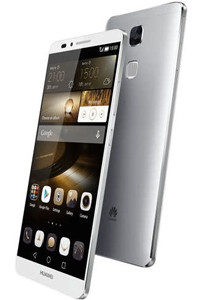
Huawei, a relatively new player in the smartphone arena, currently holds third position when it comes to global sales. Only Apple and Samsung have sold more smartphones in recent years. It is, however, no secret that Huawei has some ambitious plans for the future and that its crosshairs are focused on Samsung.
The company recently announced two new models that are set to hit the South African market early in 2015. We were able to thoroughly test and review one of those models, the high-end Huawei Ascend Mate 7. What makes this smartphone special and how suitable is it for business use?
To answer those questions, we worked intensively with the Ascend Mate 7 for a full week. While it will be available in two versions, 16GB and 32GB, we used the 16GB version for this review.
Design and fingerprint scanner
Let's get straight to the point; the 6-inch Huawei Ascend Mate 7 is a big phone. Some may even call it a phablet. Designed from the ground up to be a large device, the bezels of the Ascend Mate 7 measure only 3mm on both sides and around 10mm at the top and bottom. As a result, an impressive 79% of the Ascend Mate 7's frontal exterior consists of pure pixels. Bottom line: the Ascend Mate 7 offers a lot of screen in a relatively small housing.
It features an aluminium back cover and some plastic around the top and bottom edges. The device feels sufficiently durable and should therefore have no problem surviving the roughest of office days or business trips. It also feels very comfortable to hold, even for longer periods of time. It does not, however, have that typical refined and sophisticated look and feel offered by the HTC One (M8) and Apple iPhone 6.
On the back side, just below the camera, the Ascend Mate 7 is equipped with a fingerprint sensor. Similar-sized devices that also offer a fingerprint scanner, all have the sensor mounted at the front of the device.
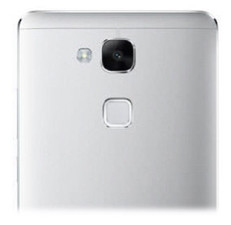
There's no need to swipe the sensor, just touching it does the trick. It also accepts a fingerprint from 360 degrees of possible input directions. In addition, you can wake the Mate 7 from sleep and unlock it with a single touch. The rear position of the fingerprint sensor is clearly well thought-out, since your fingers are already close to the sensor when picking up the device. Unfortunately, the fingerprint scanner isn't perfect and sporadically needs a second or even third touch to recognise your fingerprint. This occurs mostly when the device has been in sleep mode for a couple of hours, implying it can be fixed through future firmware updates. In the end, we think this fingerprint scanner is the best one we've encountered on any Android device.
Dual quad-core architecture
The Huawei Ascend Mate 7 is equipped with a chip that houses no less than eight separate cores. This octa-core chip was manufactured by one of Huawei's own subsidiary companies called HiSilicon. There are two core-clusters; four high performance Cortex A15 cores that operate at 1.8GHz and four energy-efficient Cortex A7's working at 1.3GHz, making it more of a dual quad-core chip.
The HiSilicon Kirin 925 chip uses a new power-optimisation technology where both fast and energy-efficient cores are combined, based on performance needs. This technology, called big.LITTLE, automatically and seamlessly moves workloads to the appropriate cores. It should ultimately result in devices that offer both high performance as well as long-lasting battery life. Huawei's marketing department skilfully plays along with this claim and promises Ascend Mate 7 users perfect balance between performance and power. A claim we naturally wanted to see for ourselves, so we used a set of benchmark tools to measure and quantify the actual performance of the HiSilicon Kirin 925 chip.
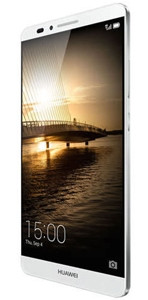
The 16GB review device we used has 2GB RAM on-board and came with Android 4.4.2 installed. The 32GB version features 3GB of RAM and may therefore show slightly different benchmark results. During our benchmarking we compared the test results of the Ascend Mate 7 with those of roughly similar sized smartphones from competitive brands.
The first benchmark we fired at the Ascend Mate 7 was Geekbench. It simulates real-world business and consumer scenarios to determine and quantify the actual (multi-core) processing power. It showed us that the 6-inch Ascend Mate 7 performed slightly better than the 5.7-inch Samsung Galaxy Note 4 with the 4-core Snapdragon 805 processor we tested at the end of October. It also proved to be considerably faster than the 5.5-inch iPhone 6 Plus, 5.0-inch HTC One (M8) and finally the 4.6-inch Sony Xperia Z3 Compact.
Our second benchmark tool is called Peacekeeper, and also factors in the performance of the operating system and browser, aside from the hardware. The iPhone 6 Plus reigns supreme on this particular test run, performing almost twice as fast as the Ascend Mate 7. The Galaxy Note 4 puts down identical performance to the Mate 7, and both the HTC One (M8) and Sony Xperia Z3 Compact seem to be considerably slower.
We then ran the Kraken benchmark that also measured the performance of the hardware, operating system and browser. It confirmed what Peacekeeper initially showed, the iPhone 6 Plus is the fastest of the lot, the Ascend Mate 7 and Galaxy Note 4 both finish second.
Finally, the GFXBench software gave us valuable insight in how the GPU (graphical processing unit) within the Ascend Mate 7 handles complex 3D-graphics. Unfortunately, the results were disappointing. The Galaxy Note 4, iPhone 6 Plus, HTC One (M8) and Xperia Z3 Compact all easily outperformed the Huawei Ascend Mate 7.
The Huawei Ascend Mate is one of the few smartphones that already supports 4G/LTE Cat6 networks, also known as 4G+. This new, faster version of 4G, which is currently being rolled out in parts of Europe and the US, isn't yet available in SA. On the other hand, it seems inevitable and only a matter of time before it will be. This makes the Ascend Mate 7 especially interesting for business users that are dependent on the fastest connection available, now or in the near future.
To keep costs low, Huawei equips the cheapest version of the Ascend Mate 7 with only 16GB of storage. Because the Android operating system requires 4GB, only 12GB is available for apps, documents, music and other content. Luckily, you can easily expand the capacity with an optional micro-SD card.
Good screen, mediocre camera
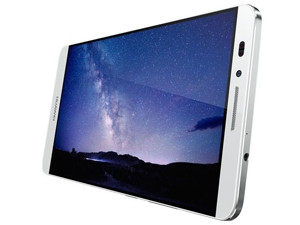
The 6-inch screen of the Ascend Mate 7 features a resolution of 1 920 x 1 080 pixels and a pixels density of 368ppi. Because of these properties, both text and images look nice and sharp. When we first saw the screen in action, we were already convinced of its quality. Naturally, we used our specialised hardware to quantify and confirm our first impression. We measured the brightness, contrast and colour reproduction of the screen.
The brightness levels don't come near that of the Sony Xperia Z3 Compact, Apple iPhone 6 Plus or the HTC One (M8), but is still very good. Content on the screen is still adequately visible when the device is used in light-intensive situations, like on a sunny day or in bright office. The measured contrast is excellent. The screen of the Apple iPhone 6 Plus and the HTC One (M8), however, are able to display even higher contrast. Colour reproduction is also pretty good, but not perfect. Only the screen of the iPhone 6 Plus was able to display colours even more accurately.
The Ascend Mate 7 offers a 13MP rear camera capable of producing some pretty good pictures and 1 080p videos, especially when two conditions are met: It needs a steady hand and ample light. If one of those, or even worse, both, are not present, the quality quickly diminishes. Despite the on-board LED flash, it can't handle low-light situations very well. Also, the auto-focus is easily confused, especially in dark situations. Nonetheless, camera quality should prove sufficient for the occasional corporate meeting, business trip or office birthday party as long as there is enough light. The 5MP camera on the front is good enough for a proper Skype call with colleagues or business contacts, as long as the room is supplied with ample light.
Unprecedented battery life
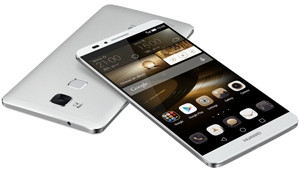
Battery life is a key consideration for business users. Longer battery life means less dependency on a power source or charger. The Huawei Ascend Mate 7 is equipped with the highest capacity battery we have come across, 4 100mAh.
To put this into perspective, the Samsung Galaxy Note 4 uses a 3 220mAh one, the Sony Xperia Z3 Compact depends on a 3 100mAh version, the Apple iPhone 6 Plus works on a 2 900mAh model and the HTC One (M8) houses a mere 2 600mAh battery.
To find out how the Ascend Mate 7 would perform in real life, we exposed it to our battery-draining test. Primarily because of its huge battery, the Ascend Mate 7 sets a new record of 11 hours on a fully charged battery. In a more realistic business situation, where the device would not be continually in use, it should have no problem lasting for an amazing 15 hours. This is especially useful for business users that often work overtime or frequently fly overseas.
Naturally, we were also curious as to how long the enormous battery in the Ascend Mate 7 would last when continuously watching 720p HD videos. We managed to squeeze an incredible 13 hours out of the Mate 7.
Verdict
Business users looking for a large Android smartphone with the best battery life currently available will undoubtedly find the Huawei Ascend Mate 7 the way to go. Besides unprecedented battery life, the device also offers decent performance, a good screen and a useful fingerprint scanner. It's also well designed, feels solid and is very compact for a device housing a 6-inch display. It seems Huawei has actually found a good balance between performance and power with the Ascend Mate 7.
Unfortunately, the camera leaves a lot to be desired, especially in low-light situations. We're also disappointed by the meagre 12GB of free space that is left for documents and files. Luckily, storage capacity can easily be expanded with an optional memory card.
Share